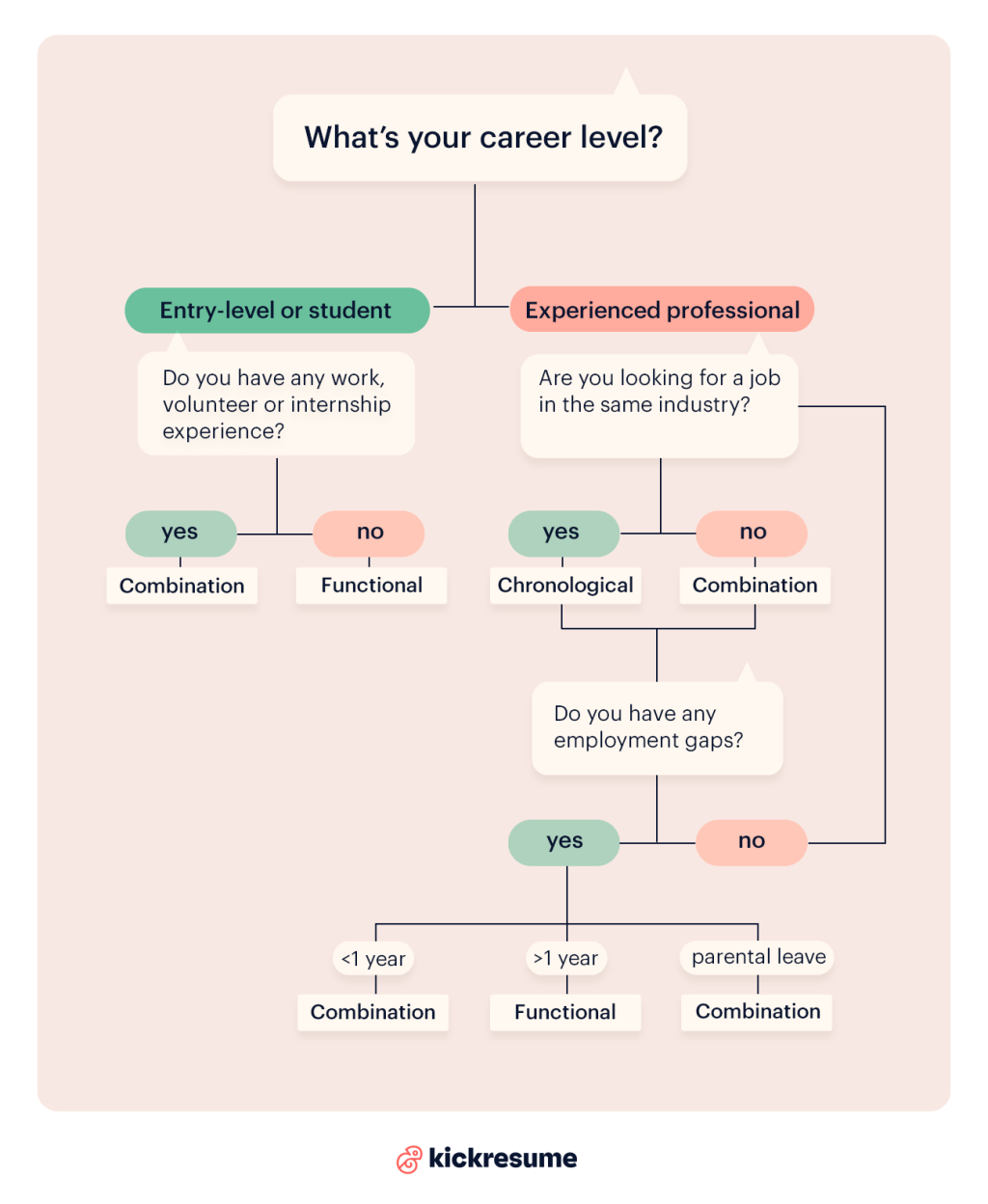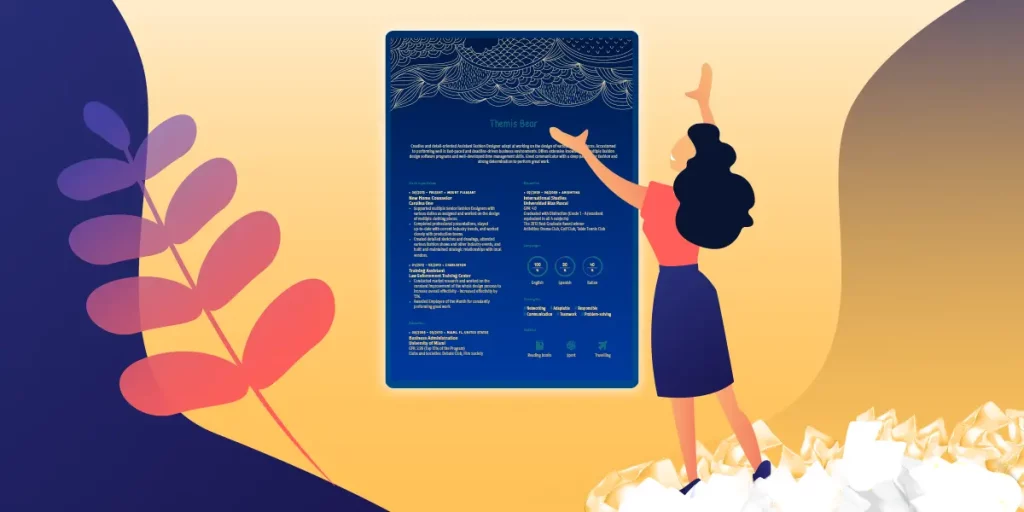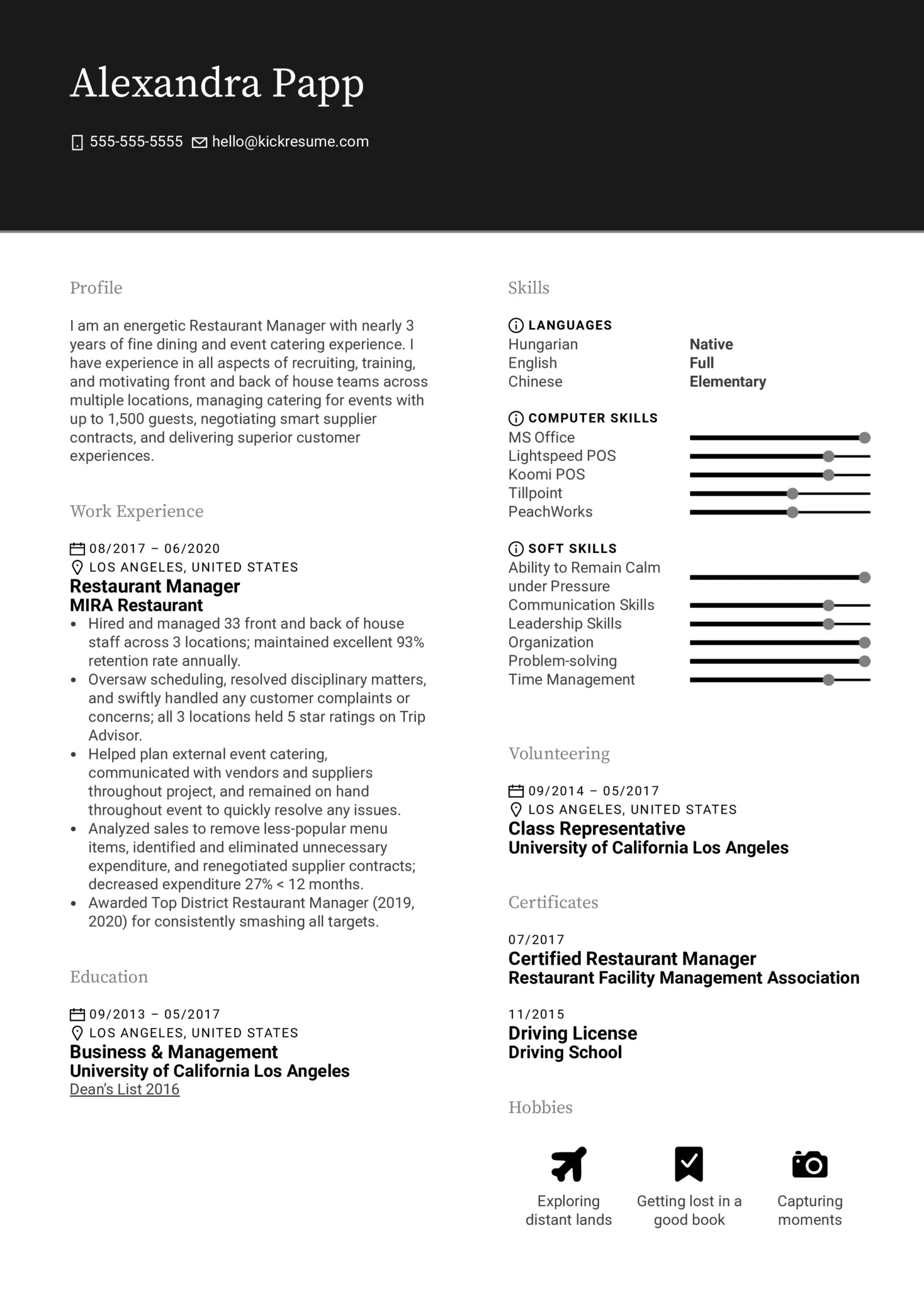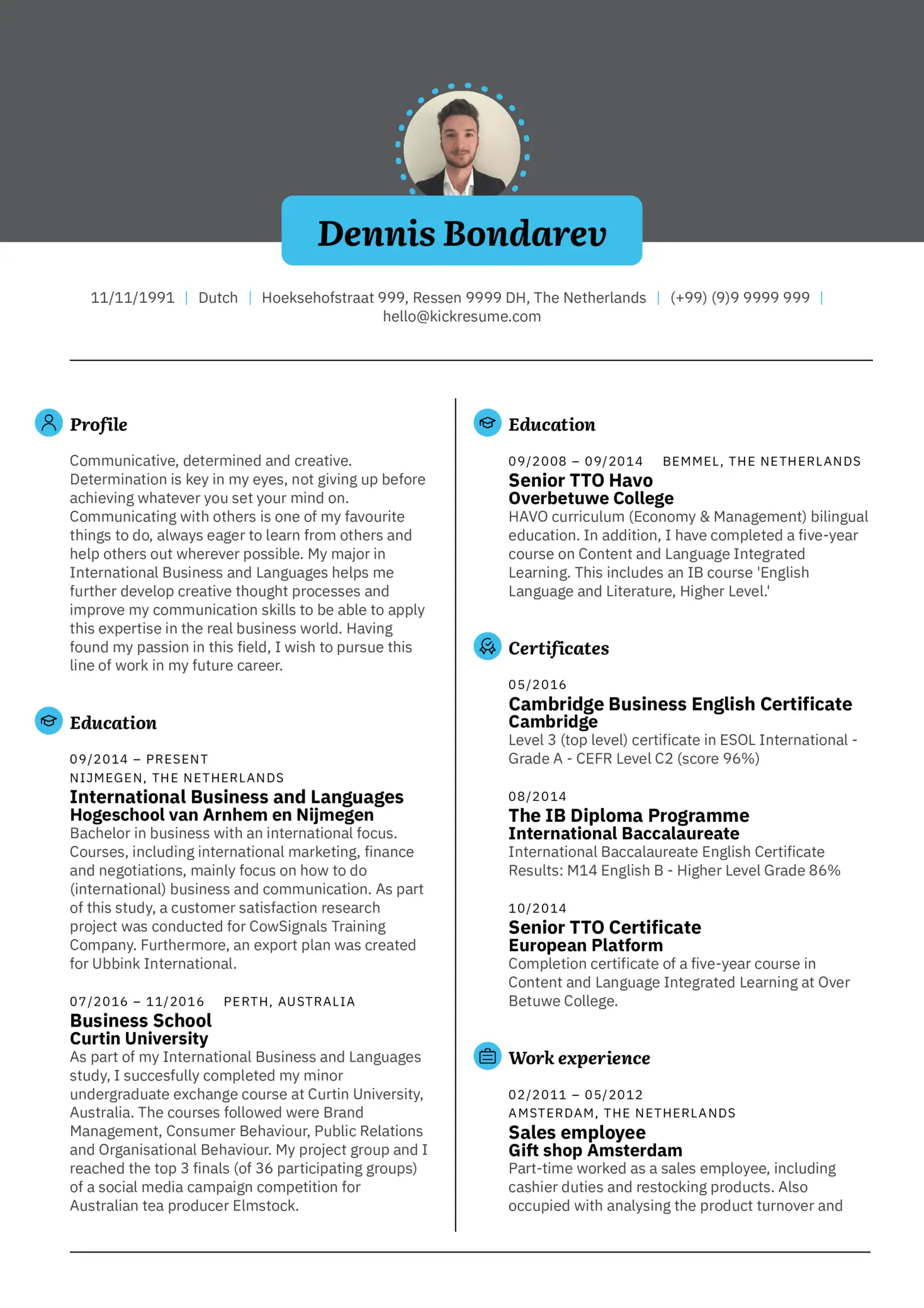Different resume formats are best-suited for different kinds of job seekers, depending on their experience level or what they want to achieve.
The three most commonly used resume formats are:
- Chronological
- Functional
- Combination (hybrid)
By choosing a suitable format, you can easily steer the HR manager's attention to certain sections and away from others.
Whether you’re a recent graduate, an experienced professional, or someone looking to change careers, there’s a format that will help highlight your unique strengths, qualifications, and work history.
This article will explore the different types of resume formats, help you decide which one is right for YOU, and show you examples of well-formatted resumes that you can use as your first draft.
Three standard resume formats
There are three standard resume formats that are most commonly used when applying for jobs:
- Chronological resume
- Functional resume
- Combination (hybrid) resume
Each of them has different attributes and serves a different purpose. Here's a chart with a quick overview of each format.
| Resume format | Main focus | Best for | Order of sections | Tip |
| Chronological | Work experience | Experienced professionals | Work experience Education Skills | Include details about your achievements using bullet points |
| Functional | Skills | Recent graduates, career-changers, after a long gap | Skills Work experience Education | Include a career objective |
| Combination | Work experience & skills | Career changers, after a short gap, for career growth | Skills Work experience Education | Include other sections, such as achievements |
| Bonus: Resume format for freshers | Education | Students | Education Skills Work experience | Highlight coursework/projects relevant for the job |
Chronological resume format
The chronological resume format is the most widely used of the bunch. In fact, if you try to think of a traditional resume, you probably think of one written in this format.
What's the main focus of a chronological resume?
This format puts the most emphasis on your work experience section, which should form the bulk of your resume. The individual work experiences should be listed in reverse chronological order (from most recent to oldest). Apart from the names and dates, include a list of your tasks, key (quantifiable) accomplishments, and skills/knowledge gained from the job.
Who is a chronological resume for?
- Experienced professionals who have a steady work history and are looking for another job in the same field.
- Those with no (or few) periods of unemployment.
- Those who want to demonstrate their career growth and highlight their promotions or achievements.
Here's an example:
Chronological resume template
This job seeker has 4+ years of experience in the given industry, making them an experienced professional. The work experience section is the main focus of this resume and apart from the key information about the employer, they also include a list of their tasks, quantifiable achievements, and other accomplishments.
Functional resume format
A functional resume is a lot less common than its chronological counterpart. However, it still has a place in the recruitment process and can be an ideal option for certain people. It's also referred to as a skills based resume, and here's why.
What's the main focus of a functional resume?
The functional resume format highlights your relevant and transferable skills and accomplishments, rather than focusing on your chronological work history. The skills section should be placed at the top of your resume and be quite detailed.
Who is a functional resume for?
- It's typically used by job seekers who have gaps in their employment history (e.g. when coming back from a leave of absence or maternity leave).
- For job seekers who are changing careers, or have limited work experience (like recent graduates).
Here's an example:
Functional resume template
This is a perfect example of how a functional resume can make up for the lack of work experience. This person is a student, which is why they don't have much work experience.
Hence, the skills section is right at the top of their resume. It's also divided into 3 categories to really highlight their capabilities. The profile section nicely complements it, touching upon some of the transferable skills.
Combined resume format
Finally, this combined resume format (also called a hybrid format) combines several aspects of the chronological and functional resume formats. Thanks to its versatility, it helps you incorporate a variety of sections into a single document.
What's the main focus of a combined resume?
As the name suggests, this resume format combines the best of both worlds. It places equal focus on work experience and skills and also engages the reader with a professional summary. It allows you to effectively highlight your diverse skill set and demonstrate it in the work experience section.
Who is a combined resume for?
- It's suitable for anyone who has both relevant work experience and skills that they want to emphasize on their resume.
- Professionals who are transitioning between similar roles or industries may also find this format very effective.
- It's perfect for those changing careers with transferable skills, such as project management, communication, or leadership, that may be applicable to multiple fields.
Here's an example:
Combined resume template
This is an exemplary combination resume. Right at the top is a resume summary that engages the reader. The work experience and skills sections form the bulk of this resume and are both very elaborate. Finally, the person also added a volunteering and certificates section as a cherry on top.
How to choose the best resume format for you?
Consider these key things to pick the resume format that best tells your story:
- Are you a seasoned professional looking to stay in the same field? If so, go for a chronological resume. A combined resume is also an option.
- Are you a fresh graduate? Then use a functional resume to highlight any transferable skills you’ve acquired during your studies or internships.
- Do you have less than 2 years of experience? A functional or combined resume are the most suited.
- Are you changing careers? A combination and functional resume formats will produce the best results.
- Are there any gaps in your employment? If the gap is short, opt for a combination resume. If it's longer, a functional resume is the better option.
- Looking to get a promotion or grow your career? A combination or chronological resume will work best.
Furthermore, think about which sections you’d like to emphasize. Is it your recent work history? Or would you rather emphasize your hard skills? Or both at the same time?
This flowchart will help you with your decision-making if you're more of a visual person:

How to organize each resume format?
Each resume, despite what format it uses, should include a few key resume sections.
However, depending on which resume format you choose, the order and content of those sections will vary.
With Kickresume's resume builder, you can re-order your resume sections however you want them. Simply click on Re-order (left from the resume sections) and drag them to the desired order.
Let's have a look at how to order the sections in each resume format:
How is a chronological resume organized?
- Contact information. First, include your name, email, location, and LinkedIn profile.
- Professional summary. Briefly reflect on the most relevant qualifications and experience.
- Work experience. It should be very detailed. Include all key information about employers, dates, your daily tasks, as well as your key accomplishments, quantifiable achievements, and any knowledge/skills acquired.
- Education. Mention the name of the institution, dates, courses, and relevant projects.
- Skills. Mention your main skills, but there's no need to go into too much detail.
- Optional sections*. These include awards, certifications, references, volunteering, etc.
*Include any optional sections that are relevant to the job or if it's anything you want to highlight.
How is a functional resume organized?
- Contact information. Name, email, location, LinkedIn profile, or other relevant socials.
- Resume objective. It briefly states your career goals and creates a connection between your skills and abilities and the position you're applying for.
- Skills. Carefully study the job description and think of skills that are desirable. If you have any, list them. In addition to listing the skills, you should also describe how you've used (or gained) them. Some of the best transferable skills to have include conflict resolution, critical thinking, and technical skills.
- Work experience. List the job titles and dates and add a key accomplishment (1 bullet point).
- Education. Names, dates, courses, and relevant projects.
- Optional sections*. These include awards, certifications, references, volunteering, etc.
*Include any optional sections that are relevant to the job or if it's anything you want to highlight.
How is a combined resume organized?
- Contact information. Include your name, email, location, and LinkedIn profile.
- Professional summary. A concise overview of your experience and accomplishments.
- Skills. Study the job description and try to cherry-pick the most relevant skills. Ideally, divide them into soft & hard skills.
- Work experience. In reverse-chronological order, include all of the key information about the employers, the dates, your daily tasks, key (quantifiable) accomplishments, and any knowledge/skills acquired. You shouldn't be repetitive, so try to vary the language.
- Education. Mention the name of the institution, dates, courses, and relevant projects.
- Other sections. You should include another section that highlights your experience or is relevant to the job. These include: awards, certifications, professional references, publications, etc.
Fresher resume format
And what if you're still a student or you're a graduate fresh out of college? Well, then you should prioritize your education section by placing it before work experience.
In the education section, make sure to highlight relevant coursework and other projects that demonstrate the skills and attributes the hiring managers are looking for and are relevant for the specific job or internship.
Provided that you don’t have much professional experience, consider adding a section about volunteer experiences or extracurricular activities that demonstrate your capabilities.
Here's a sample of a fresher resume format, belonging to a student hired for an internship at Philips:
Tips for how to format any resume
Additionally, apart from choosing the right resume format, your overall resume formatting should also meet the standards.
Here's a brief summary of the resume formatting recommendations:
- Use a standard font. Ensure your resume is easy to read by using a standard font like Arial, Times New Roman, or Calibri and a font size of 11 to 12 points.
- Use bullet points. Use bullet points to make your resume easier to scan and highlight important information quickly.
- Think about the margins. Strike a good balance between not leaving too much white space and making your resume seem cluttered.
- Keep it to one-two pages. Unless you have extensive work experience, you should generally aim to keep your resume to one page.
- Consistency is key. In all aspects of your resume, including the spacing, font, margins, etc.
- Use a professional template or layout which helps to structure the information effectively and makes it easy to read.
- Consider ATS friendly templates. While not always necessary, an ATS-friendly resume ensures you pass screenings and catch recruiters' attention.
However, if you don't want to bother with manually formatting your resume, you can opt for a pre-formatted resume template.
Kickresume offers resume templates that were carefully designed by professional typographers and approved by HR experts to create the perfect resume hassle-free and quickly.
All templates are already pre-formatted, so you can go directly to filling in the content.
Have a look at some resume templates that got the formatting just right and got hired by Accenture and Amazon:
Key takeaways: Choosing the best resume format in 2025
In 2025, the modern combination resume may prove to be the most effective resume format as it allows you to highlight your skills, qualifications, and past work experience all at once.
However, the most suitable resume format for you is one that best reflects your individual objectives and career stage.
Your ultimate goal is to help recruiters extract key information about you as quickly as possible. The resume format is the tool that helps you do that.
What's more, the proper layout of a resume with well-defined individual sections will make your resume look good and professional.
Let’s recap 3 main points concerning the resume format:
- Make that format choice. Think about things you’re proud of. Is it your extensive work history or a broad array of skills? If it’s a no-brainer, use either a chronological or functional resume. If it's all closely intertwined, go for a combined resume format.
- Put the best parts first. The top one-third of your resume is where the most important stuff is. Whether it’s your skills, work history, or education, make it stand out.
- Use resume templates. These are already pre-formatted for you, and you can re-order the sections simply by dragging.
FAQ: Resume format
- What is the best resume format?
The combination resume is the most effective resume format as it allows you to highlight your skills, qualifications, and past work experience all at once.
- How to format a resume?
1. Include standard resume sections. Contact information, resume summary, work experience, education, skills.
2. Include optional resume sections. Awards, references, certifications, publications, projects, etc.
3. Choose a resume format. The three standard are: chronological, functional, combination.
4. Use bullet points. Use bullet points to make your resume easier to scan and highlight important information quickly.
6. Think about the margins. Strike a good balance between not leaving too much white space and making your resume seem cluttered.
7. Keep it to one-two pages. Unless you have extensive work experience, you should generally aim to keep your resume to one page.
8. Consistency is key. In all aspects of your resume, including the spacing, font, margins, etc.
9. Use a professional resume template or layout which helps to structure the information effectively and makes it easy to read. - How to format references on resume?
Here's what you should list for each reference:
1. Their full name
2. Their current job title and organization
3. Their contact details (email and phone number will do)
4. Your relationship with them (e.g., Former Supervisor) - How should you adjust your resume format for ATS (Applicant Tracking Systems)?
Use a clean, simple layout with standard fonts, bullet points, and headings like "Work Experience" or "Education." Avoid graphics, tables, or non-standard fonts that ATS might not recognize.
This article was recently updated. The original article was written by Jakub Kaprál in 2020.









